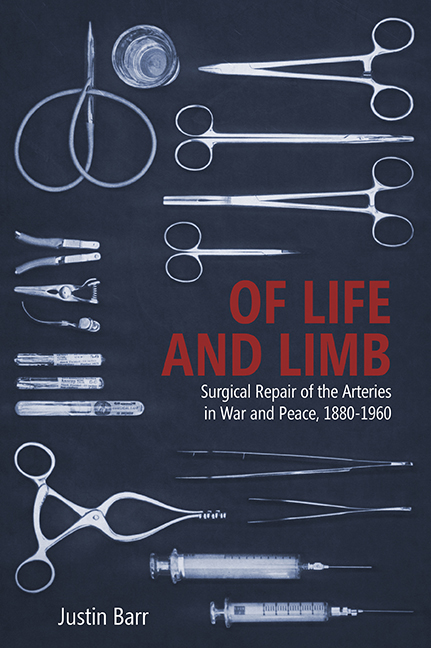 Surgical Repair of the Arteries in War and Peace, 1880–1960
Surgical Repair of the Arteries in War and Peace, 1880–1960 Book contents
- Frontmatter
- Contents
- Acknowledgments
- Introduction
- 1 Technical Change, Practical Stasis: The Development of Arterial Repair through 1914
- 2 An Ideal Rarely Practiced: Arterial Repair and Its Alternatives from World War I to World War II
- 3 Opportunities Realized and Discarded: The Management of Vascular Trauma in World War II
- 4 Reshaping Surgical Infrastructure between World War II and the Korean War
- 5 An Ideal Implemented: Arterial Repair in the Korean War
- 6 Bringing It All Back Home
- Conclusion: Arterial Repair and the Process of Surgical Change
- Notes
- Bibliography
- Index
Conclusion: Arterial Repair and the Process of Surgical Change
Published online by Cambridge University Press: 29 March 2020
- Frontmatter
- Contents
- Acknowledgments
- Introduction
- 1 Technical Change, Practical Stasis: The Development of Arterial Repair through 1914
- 2 An Ideal Rarely Practiced: Arterial Repair and Its Alternatives from World War I to World War II
- 3 Opportunities Realized and Discarded: The Management of Vascular Trauma in World War II
- 4 Reshaping Surgical Infrastructure between World War II and the Korean War
- 5 An Ideal Implemented: Arterial Repair in the Korean War
- 6 Bringing It All Back Home
- Conclusion: Arterial Repair and the Process of Surgical Change
- Notes
- Bibliography
- Index
Summary
In 1880, no operation to repair or anastomose arteries existed. By 1960, surgeons across the United States were applying these new techniques to arrest traumatic bleeding, keep aneurysms from rupturing, and prevent atherosclerotic vascular disease from irreversibly clogging vessels. Alexis Carrel receives the majority of credit for inventing arterial repair, although, as with most famous names attached to a procedure, Carrel followed and adopted advances established by his predecessors. These pages have explored this process of technical development in depth to unveil unique aspects of surgical culture like the prioritization of practice over theory, the reliance on animals, and the crucial importance of in-person communication for the transfer of knowledge. Despite its promise, arterial repair paradoxically remained confined to textbooks and a handful of elite practitioners for half a century.
While the creation of a potentially curative operation is critical, the trajectory of arterial repair shows that this stage is but one step to understanding surgical change. Demonstrating the broad acceptance of a procedure and exploring how that process transpired are equally important components to the history. Examining that transformation, this book explicitly distinguishes surgical innovations from medical ones by highlighting the manual manipulations unique to operating. These features required a more parallel system of transferring knowledge that demanded prolonged training to acquire the necessary expertise and in-person teaching to convey the specific techniques. Ironically, surgical innovation has received less historical attention than other medical and public health interventions despite the strong historical interest among surgeons.
In a recent review, Christopher Lawrence characterized surgical innovation as a “slippery fish”—examples for individual operations exist, but allencompassing explanations continue to escape the grasp of historians. The history of arterial repair simultaneously reinforces and rebuts his argument. The preceding chapters empirically investigated the nuanced evolution of arterial repair, demonstrating the impossibility of understanding the development of any operation without analyzing the elements and environment specific to that case. Yet, at the same time, the example of arterial repair can work as an effective case study to explore universal themes of how and why surgery evolves. This book has emphasized the importance of considering vectors of stasis and change ranging from the broadest social and cultural factors to the most specific technical details. While particular elements will vary on a case-by-case basis, certain tropes are conserved.
- Type
- Chapter
- Information
- Surgical Repair of the Arteries in War and Peace, 1880–1960Surgical Repair of the Arteries in War and Peace, 1880–1960, pp. 156 - 160Publisher: Boydell & BrewerPrint publication year: 2019


